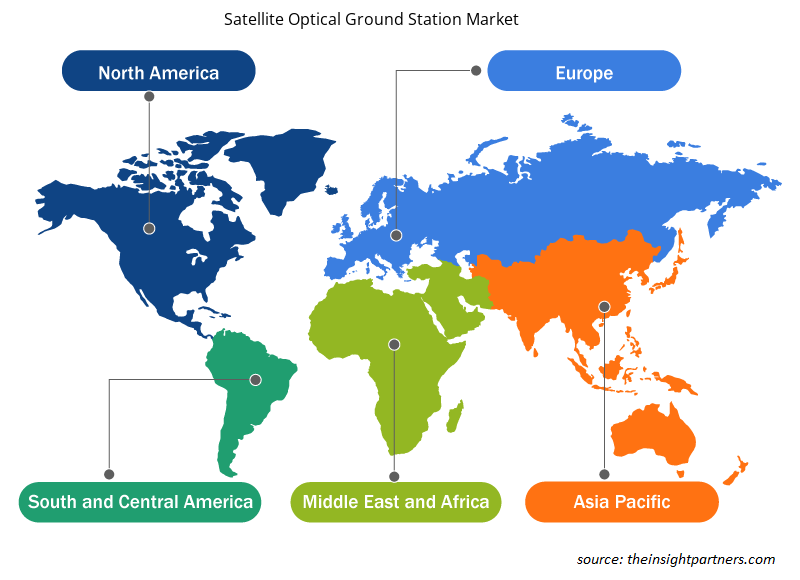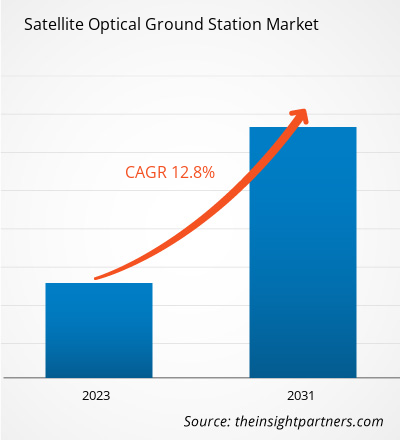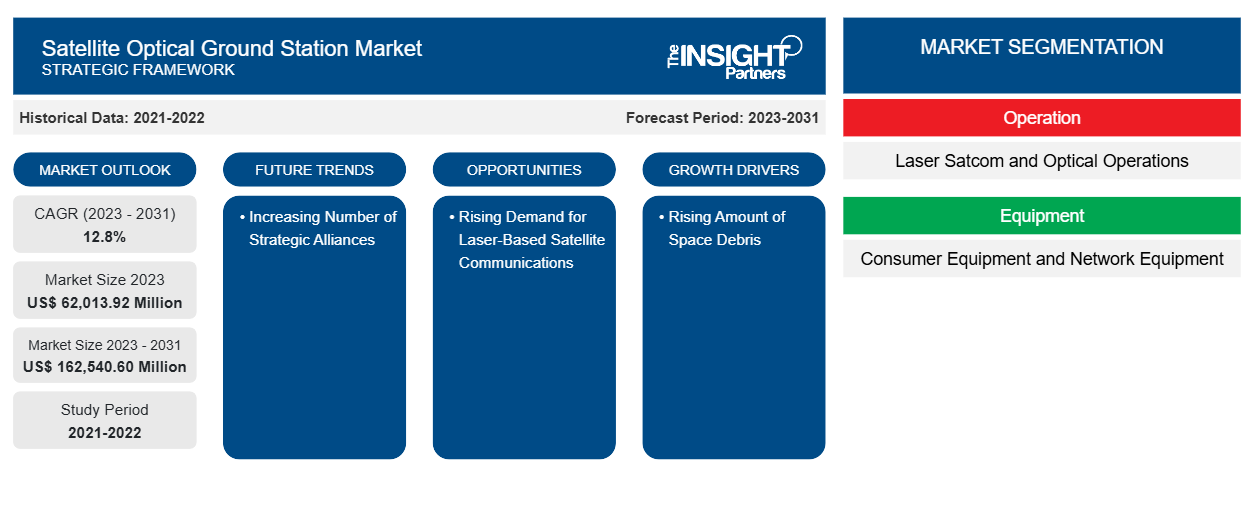Se prevé que el tamaño del mercado de estaciones terrestres ópticas para satélites alcance los 162.540,60 millones de dólares en 2031, frente a los 62.013,92 millones de dólares en 2023. El aumento de la construcción de nuevos aeropuertos en todo el mundo está contribuyendo a la mayor demanda de soluciones de redes de comunicaciones. El creciente número de lanzamientos de satélites a nivel mundial está impulsando la demanda de estaciones terrestres ópticas para rastrear y monitorear el movimiento de los satélites y recibir y transmitir datos simultáneamente. Además, los OGS avanzados están generando demanda para su ayuda en el monitoreo de estos satélites. Además, la demanda de OGS está impulsando la prevención de la amenaza de colisión de desechos espaciales con activos espaciales funcionales. Los OGS también ayudan a garantizar actividades espaciales seguras y sostenibles que cumplan con las pautas, estándares y otras normas nacionales e internacionales.
Análisis del mercado de estaciones terrestres ópticas satelitales
El número de lanzamientos de satélites está aumentando a nivel mundial debido a la creciente necesidad de satélites en diversas aplicaciones, como la observación de la Tierra, la comunicación y la navegación y la investigación científica. Según varias agencias espaciales, en promedio, se lanzaron ~466 SmallSats por año durante 2012-2021, y se espera que aumente a 1.846 lanzamientos de SmallSats por año durante 2022-2031. Para el lanzamiento de estos 4.663 SmallSats durante 2012-2021, los gobiernos de varios países y empresas invirtieron ~US$ 23.1 mil millones, y se espera que inviertan más de US$ 84 mil millones durante 2022-2031. Además, el número de lanzamientos de cohetes espaciales , principalmente para desplegar satélites en el espacio, también está aumentando rápidamente. En 2021, hubo 136 lanzamientos de cohetes exitosos, mientras que en 2022, el número aumentó a 180. En septiembre de 2022, se observó que se llevaron a cabo 16 lanzamientos orbitales, de los cuales 8 tuvieron lugar en China, 6 en América y Europa y Rusia realizaron uno cada uno. Además, Falcon 9 lanzó 191 satélites de banda ancha Starlink y SpaceX lanzó 1.465 satélites Starlink en 2022. Nuevamente, en enero de 2023, China lanzó 14 satélites a bordo de un cohete portador Long March-2D desde el Centro de Lanzamiento de Satélites de Taiyuan en la provincia de Shanxi, en el norte de China. Los 14 satélites incluían Qilu-2 y Qilu-3, Luojia-3 01 y Jilin-1 Gaofen 03D34. En febrero de 2023, la Organización de Investigación Espacial de la India (ISRO) anunció el despliegue exitoso de tres satélites en sus órbitas previstas a través del vehículo SSLV-D2.
Descripción general del mercado de estaciones terrestres ópticas satelitales
Una estación terrestre óptica (OGS) es una parte vital de la infraestructura que conecta el espacio con la tierra. El sistema ayuda a proporcionar comunicaciones en tiempo real para diversas aplicaciones a velocidades de datos mucho más altas (hasta varios Gbps) que las de RF. La creciente necesidad de datos de mayor resolución para misiones que requieren que los científicos obtengan una visión detallada de la Tierra y el sistema solar da como resultado una gran demanda de sistemas OGS. El sistema también ayuda a proporcionar grandes volúmenes de datos para cumplir con los requisitos de la misión y ubicar los activos terrestres en relación con los parámetros de la órbita de la misión. Por lo tanto, la demanda de OGS está aumentando a nivel mundial para una transferencia de datos más precisa y de alta velocidad.
Personalice este informe según sus necesidades
Obtendrá personalización en cualquier informe, sin cargo, incluidas partes de este informe o análisis a nivel de país, paquete de datos de Excel, así como también grandes ofertas y descuentos para empresas emergentes y universidades.
-
Obtenga las principales tendencias clave del mercado de este informe.Esta muestra GRATUITA incluirá análisis de datos, desde tendencias del mercado hasta estimaciones y pronósticos.
Impulsores y oportunidades del mercado de estaciones terrestres ópticas satelitales
Aumento de la cantidad de desechos espaciales
Todos los materiales artificiales no funcionales que orbitan la Tierra a diferentes altitudes pueden denominarse desechos espaciales. Los desechos incluyen partes del cuerpo de cohetes, restos de fragmentación, desechos creados durante misiones tripuladas, productos de escape de cohetes y satélites fuera de servicio. La mayoría de estos desechos orbitan la Tierra a una velocidad promedio superior a 26.000 km por hora en órbitas terrestres bajas (LEO), lo que plantea una grave amenaza de colisión para los activos espaciales funcionales. Estas amenazas aumentan con cada lanzamiento de cohetes para LEO y espacio profundo. Las crecientes amenazas de colisión de objetos espaciales son un problema persistente para el uso seguro y sostenible del espacio ultraterrestre. Estas amenazas restringen el acceso sin obstáculos al espacio e incitan a las partes pertinentes a tomar las medidas necesarias para mitigar el riesgo. En noviembre de 2021, el ejército ruso realizó una prueba antisatélite (ASAT) e hizo estallar su extinto satélite Cosmos 1408 (que se lanzó en 1982) con un misil Nudol. Inmediatamente después de la explosión, los astronautas estadounidenses y rusos a bordo de la Estación Espacial Internacional tuvieron que tomar medidas preventivas para evitar ser golpeados por los restos del satélite, ya que la Estación Espacial Internacional se encontraba supuestamente razonablemente cerca del satélite. En junio de 2022, la Estación Espacial Internacional tuvo que realizar nuevamente una maniobra de prevención de colisiones (CAM) para evitar los restos orbitales del satélite destruido. La agencia espacial rusa Roscosmos utilizó una nave de carga Progress 81 sin tripulación para apartar la estación espacial de la trayectoria de los escombros. En 2021, la ISRO llevó a cabo 19 CAM, en comparación con 12 y 8 CAM en 2020 y 2019, respectivamente.
Aumento del número de alianzas estratégicas
La creciente demanda de estaciones terrestres ópticas satelitales alienta a las empresas a desarrollar soluciones avanzadas para la expansión de la industria espacial . Para esta expansión, los gobiernos de diferentes países y las partes interesadas en los sectores verticales de la industria están invirtiendo continuamente en I+D. Prefieren diversas alianzas estratégicas, como asociaciones, colaboraciones y contratos, algunas de las cuales se mencionan a continuación:
• En marzo de 2023, CONTEC anunció que había elegido a Cailabs para suministrar una estación terrestre óptica que se instalará en 2024. Esta nueva estación terrestre óptica incorporará el componente TILBA-ATMO para comunicaciones confiables y de alta velocidad. Además, la estación terrestre será compatible con CCSDS, SDA y QKD.
• En febrero de 2023, la Agencia Espacial de Ruanda (RSA) anunció una asociación con ATLAS Space Operations Inc. para construir infraestructura terrestre satelital en Ruanda. En virtud de este acuerdo, RSA está construyendo un telepuerto capaz de albergar múltiples estaciones terrestres para dar servicio a satélites en diferentes órbitas.
• En septiembre de 2022, Safran Data Systems anunció que había firmado un contrato con CONTEC para entregar una estación terrestre óptica que se instalará en Australia Occidental. Safran entregará una estación terrestre óptica (OGS) llave en mano, que constará de una montura que ofrece una cobertura óptima; un telescopio de 50 cm; un sistema completo de apuntamiento, adquisición y seguimiento; y una cúpula giratoria.
• En septiembre de 2022, SSC anunció que la Agencia Espacial Europea (ESA) le había adjudicado un contrato por 1,09 millones de dólares (1,1 millones de euros) para apoyar el desarrollo del proyecto de comunicación óptica Red de estaciones ópticas para la transferencia de datos a la Tierra desde el espacio (NODES). En virtud de este contrato, SSC encargó a Cailabs la entrega de una estación terrestre en Australia Occidental, cuyo inicio de pruebas está previsto para principios de 2024.
De esta manera, a través de contratos y asociaciones, varias empresas están trabajando para proporcionar estaciones terrestres ópticas avanzadas, que se prevé que ofrecerán oportunidades potenciales de crecimiento para el mercado de estaciones terrestres ópticas satelitales durante el período de pronóstico.
Informe de mercado de estaciones terrestres ópticas satelitales Análisis de segmentación
Los segmentos clave que contribuyeron a la derivación del análisis del mercado de estaciones terrestres ópticas satelitales son la operación, la aplicación, el usuario final y el equipo.
- Por su funcionamiento, el mercado de estaciones terrestres ópticas satelitales se divide en comunicaciones por satélite láser y operaciones ópticas. Las soluciones incluyen software como la red Smartsky, la red Iridium, SITA connect y AirportHub. El segmento de operaciones ópticas tuvo la mayor participación de mercado en 2023.
- Por aplicación, el mercado de estaciones terrestres ópticas satelitales se segmenta en operaciones láser, identificación de desechos, observación de la Tierra y conocimiento de la situación espacial. El segmento de observación de la Tierra tuvo una mayor participación de mercado en 2023.
- En función del usuario final, el mercado de estaciones terrestres ópticas satelitales se divide en segmentos gubernamentales, militares y comerciales. El segmento gubernamental y militar tuvo una mayor participación de mercado en 2023.
- Por equipamiento, el mercado de estaciones terrestres ópticas satelitales se segmenta en equipos de consumo y equipos de red. El segmento de equipos de red tuvo una mayor participación de mercado en 2023.
Análisis de la cuota de mercado de estaciones terrestres ópticas por satélite por geografía
El mercado norteamericano de estaciones terrestres ópticas satelitales está segmentado en Estados Unidos y Canadá. Las tecnologías avanzadas de estaciones terrestres ópticas satelitales se están adoptando ampliamente en Estados Unidos y Canadá para mejorar las capacidades de defensa. En agosto de 2020, el Centro Espacial de Estados Unidos anunció que se le había otorgado a United Launch Alliance (ULA) el lanzamiento de sus misiones espaciales críticas de seguridad nacional para la Fuerza Espacial de Estados Unidos. Está previsto que las misiones se desplieguen desde la Estación de la Fuerza Aérea de Cabo Cañaveral en Florida en el año fiscal 2027. Este tipo de lanzamientos de satélites ayudan a la adopción de tecnologías de estaciones terrestres.
Además, el lanzamiento de nuevas estaciones terrestres satelitales en toda la región y la expansión de las estaciones terrestres existentes son otros factores importantes que impulsan el crecimiento de las estaciones terrestres ópticas satelitales en toda la región de América del Norte. Por ejemplo:
• En 2022, BlueHalo ganó un contrato por valor de 1.400 millones de dólares de la Fuerza Espacial de Estados Unidos para la modernización de 12 estaciones terrestres militares en todo el país, en el que BlueHalo reemplazará las antiguas antenas parabólicas por antenas electrónicas de matriz en fase en todas las estaciones terrestres militares.
• En febrero de 2023, el operador de satélite KSAT anunció que está ampliando su red con la instalación de nuevas antenas de estaciones terrestres en toda la Antártida y ampliando su capacidad en EE. UU. a través de múltiples antenas en Hawái, Alaska y el sureste de EE. UU.
• En enero de 2023, Starlink de SpaceX anunció el lanzamiento de su flota de satélites de segunda generación y la expansión de la infraestructura de su estación terrestre en todo Estados Unidos.
• En mayo de 2019, GigaSat, parte de Ultra Electronics Communications & Integrated Systems (CIS), en asociación con Inmarsat, entregó 16 terminales de estación terrestre satelital multibanda al Departamento de Defensa Nacional (DND) de Canadá.
Es probable que estos avances catalicen el crecimiento de las estaciones terrestres de satélite en toda la región. Además, el aumento del número de lanzamientos de satélites es otro factor importante que probablemente genere nuevas oportunidades para los proveedores del mercado durante el período previsto.
Perspectivas regionales del mercado de estaciones terrestres ópticas satelitales
Los analistas de Insight Partners explicaron en detalle las tendencias y los factores regionales que influyen en el mercado de estaciones terrestres ópticas satelitales durante el período de pronóstico. Esta sección también analiza los segmentos y la geografía del mercado de estaciones terrestres ópticas satelitales en América del Norte, Europa, Asia Pacífico, Oriente Medio y África, y América del Sur y Central.

- Obtenga datos regionales específicos para el mercado de estaciones terrestres ópticas satelitales
Alcance del informe de mercado de estaciones terrestres ópticas satelitales
| Atributo del informe | Detalles |
|---|---|
| Tamaño del mercado en 2023 | US$ 62.013,92 millones |
| Tamaño del mercado en 2031 | US$ 162.540,60 millones |
| CAGR global (2023 - 2031) | 12,8% |
| Datos históricos | 2021-2022 |
| Período de pronóstico | 2023-2031 |
| Segmentos cubiertos |
Por Operación
|
| Regiones y países cubiertos |
América del norte
|
| Líderes del mercado y perfiles de empresas clave |
|
Densidad de actores del mercado: comprensión de su impacto en la dinámica empresarial
El mercado de estaciones terrestres ópticas satelitales está creciendo rápidamente, impulsado por la creciente demanda de los usuarios finales debido a factores como la evolución de las preferencias de los consumidores, los avances tecnológicos y una mayor conciencia de los beneficios del producto. A medida que aumenta la demanda, las empresas amplían sus ofertas, innovan para satisfacer las necesidades de los consumidores y aprovechan las tendencias emergentes, lo que impulsa aún más el crecimiento del mercado.
La densidad de actores del mercado se refiere a la distribución de las empresas o firmas que operan dentro de un mercado o industria en particular. Indica cuántos competidores (actores del mercado) están presentes en un espacio de mercado determinado en relación con su tamaño o valor total de mercado.
Las principales empresas que operan en el mercado de estaciones terrestres ópticas satelitales son:
- Thales SA
- Corporación Ball
- Base espacial AAC Clyde
- Hensoldt AG
- Sistemas aeronáuticos de General Atomics Inc.
- Tesat-Spacecom GmbH & Co. KG (empresa de telecomunicaciones)
Descargo de responsabilidad : Las empresas enumeradas anteriormente no están clasificadas en ningún orden particular.

- Obtenga una descripción general de los principales actores clave del mercado de estaciones terrestres ópticas satelitales
Noticias y desarrollos recientes del mercado de estaciones terrestres ópticas satelitales
El mercado de estaciones terrestres ópticas satelitales se evalúa mediante la recopilación de datos cualitativos y cuantitativos posteriores a la investigación primaria y secundaria, que incluye publicaciones corporativas importantes, datos de asociaciones y bases de datos. A continuación, se incluye una lista de los avances en el mercado en materia de innovaciones, expansión comercial y estrategias:
- En abril de 2023, HENSOLDT AG, una de las empresas líderes de la industria de defensa europea, fue ascendida al MDAX, el índice de mediana capitalización de la Bolsa de Frankfurt. La empresa, que salió a bolsa en septiembre de 2020, ha seguido de forma constante su trayectoria de crecimiento y ha aumentado continuamente su capacidad innovadora. Ha aumentado las inversiones, ampliado su cartera de productos y realizado adquisiciones estratégicas en todo el mundo. (Fuente: HENSOLDT AG, nota de prensa)
- En abril de 2023, Ball Aerospace, Loft Federal y Microsoft se unieron para trabajar en el programa de pruebas experimentales de la Agencia de Desarrollo Espacial (SDA), llamado NExT, para poner en órbita 10 satélites con cargas útiles experimentales. Ball Aerospace es el contratista principal, que lidera la integración y las pruebas de la carga útil y la nave espacial. Loft Federal se encargará de la integración y las pruebas de la nave espacial, adquirirá servicios de lanzamiento comercial y operará la constelación en órbita. Mientras tanto, Microsoft proporcionará a Azure Government la infraestructura de la estación terrestre y la nube con operaciones satelitales seguras posteriores al lanzamiento y soluciones de productividad para impulsar las comunicaciones de misión crítica. La colaboración tiene como objetivo establecer un proceso de entrega rápida independiente del proveedor para permitir el éxito de la misión de la SDA. (Fuente: Ball Aerospace, comunicado de prensa)
Informe sobre el mercado de estaciones terrestres ópticas satelitales: cobertura y resultados
El informe “Tamaño y pronóstico del mercado de estaciones terrestres ópticas satelitales (2021-2031)” proporciona un análisis detallado del mercado que cubre las siguientes áreas:
- Tamaño y pronóstico del mercado de estaciones terrestres ópticas satelitales a nivel global, regional y nacional para todos los segmentos clave del mercado cubiertos por el alcance.
- Dinámica del mercado, como impulsores, restricciones y oportunidades clave
- Tendencias del mercado de estaciones terrestres ópticas satelitales
- Análisis detallado de las cinco fuerzas de Porter y PEST y FODA
- Análisis del mercado de estaciones terrestres ópticas satelitales que abarca las tendencias clave del mercado, el marco global y regional, los principales actores, las regulaciones y los desarrollos recientes del mercado
- Panorama del mercado de estaciones terrestres ópticas satelitales y análisis de la competencia que cubre la concentración del mercado, análisis de mapas de calor, actores destacados y desarrollos recientes.
- Perfiles detallados de empresas
- Análisis histórico (2 años), año base, pronóstico (7 años) con CAGR
- Análisis PEST y FODA
- Tamaño del mercado, valor/volumen: global, regional y nacional
- Industria y panorama competitivo
- Conjunto de datos de Excel
Informes recientes
Testimonios
Razón para comprar
- Toma de decisiones informada
- Comprensión de la dinámica del mercado
- Análisis competitivo
- Información sobre clientes
- Pronósticos del mercado
- Mitigación de riesgos
- Planificación estratégica
- Justificación de la inversión
- Identificación de mercados emergentes
- Mejora de las estrategias de marketing
- Impulso de la eficiencia operativa
- Alineación con las tendencias regulatorias























 Obtenga una muestra gratuita para - Mercado de estaciones terrestres ópticas para satélites
Obtenga una muestra gratuita para - Mercado de estaciones terrestres ópticas para satélites